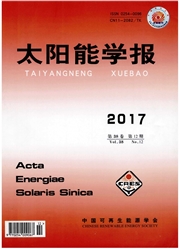

 中文摘要:
中文摘要:
从降低建筑空调负荷的角度出发,对外壁面有隔热涂层的房间建立了稳态传热模型,用数值方法逐一分析了涂层的各种参数,包括导热系数、厚度、表面太阳吸收率、发射率以及地区因素等对空凋负荷的影响。研究发现:隔热涂层能显著降低空调负荷及能耗;仅当涂层热阻与墙体热阻之比大于0.2时,涂层导热系数的降低才会对空调负荷产生显著影响;涂层表面太阳吸收率和发射率对空调负荷的影响非常大,是起主导作用的因素;隔热涂层用在太阳辐照密度越大、日最高气温越低、日较差越大的地区节能率越高,越有利于发挥其降低空调负荷及日累计能耗的功能;决定着空调运转时问长短的当地室外气温分布状况对于评价隔热涂层节能效果也有重要影响。
 英文摘要:
英文摘要:
A steady state heat transfer model was constructed to simulate the effect of the thermal insulation coatings (TICs) on the building cooling load. The influences of the TICs parameters, such as the thermal conductivity, thickness, solar absorptivity, emissivity, and the ambient parameters, were analyzed numerically. It is found out that the cooling load could be decreased remarkably by the application of TICs to the building outer wall surface; only when the ratio of TICs' thermal resistance to the wall's is larger than 0.2, the TICs' thermal conductivity can have a strong influence on the cooling load; TICs' surface solar absorptivity and emittance are the dominant factors to the cooling load; the function of the TICs is distinct in the regions with more intensive solar radiation, lower outdoor diurnal top air-temperature and larger diurnal range of temperature, and in thus regions a higher energy conservation rate and lower diurnal energy consumption could be obtained by using TICs; the distribution of the local outdoor air-temperature which determine the air- conditioning running time has important influence on the evaluating of the energy conservation effects of the TIC.
 同期刊论文项目
同期刊论文项目
 同项目期刊论文
同项目期刊论文
 期刊信息
期刊信息
